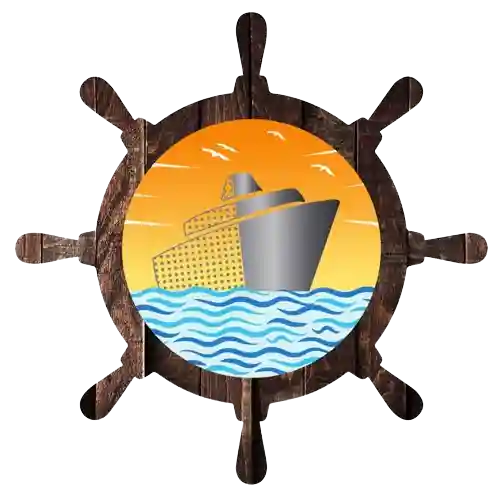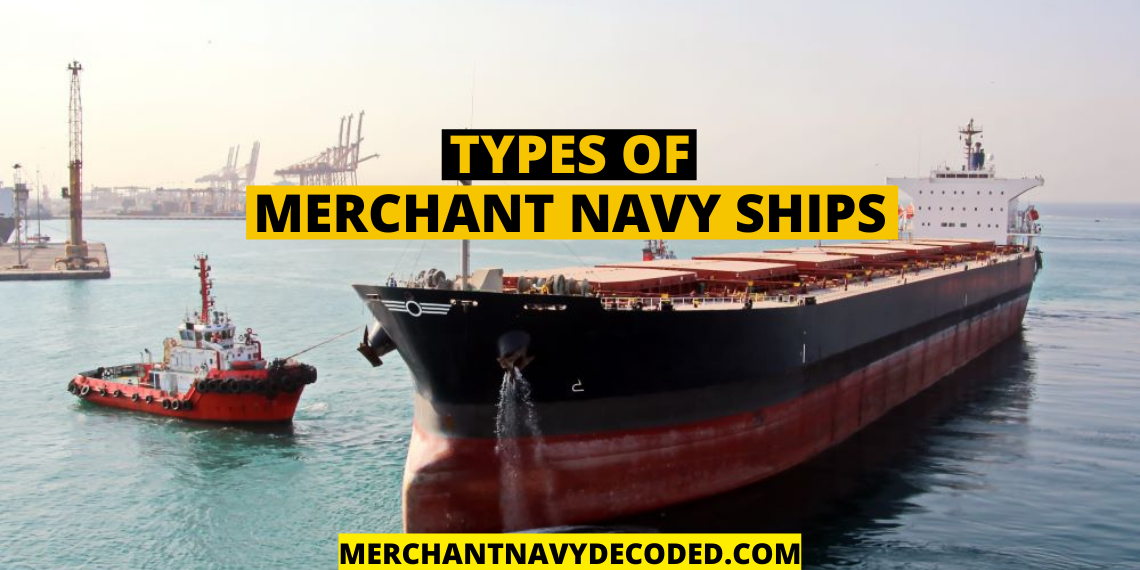Ships in Merchant Navy

Commercial ships are various kinds of ships that transport cargo and passengers to different destinations. Commercial ships come in a range of sizes and shapes, to enable them to complete their intended purpose or duty. From freight liner ships to oil tankers, these ships are all designed to serve different purposes.
Different types of commercial ships can be classified on the basis of three properties: cargo capacity, weight, and size. The number of canal locks a ship may pass through is limited by its maximum dimensions, such as length and beam (beam); water depth (draught) is a constraint for canals, shallow straits, and ports; and height is a restriction for going under bridges. Ships are often custom-built for the operation, including cranes and other loading and unloading equipment, and come in a wide range of sizes.
If you want to know about the life of Officers and Engineers and want to be one of them but do not have a clear idea about how to join the Merchant Navy then fret not as Merchant Navy Decoded offers various free courses like How to Join Merchant Navy for beginners and paid packages like COMBO Package for professionals.
Types of Merchant Navy Ships-
We have attempted to describe a few forms of merchant vessels, to thoroughly address and answer the question- “What are the different types of ships?” However, these are not limited to them.
1) Crude Oil Tanker
Crude Oil Tankers transport an enormous amount of crude oil from the extraction site to refineries, where it is further processed. Generally, a Crude Oil Tanker carries one cargo grade at a time. Crude oil is categorized into different varieties (crude grades). A crude oil ship normally transports just one cargo grade at a time. These tankers are substantially bigger than all the other types of oil vessels, ranging in size from 50,000 to over 500,000 tonnes deadweight, and hence they frequently load and unload at offshore buoys and terminals. An extensive global fleet of Crude Oil Tankers forms the backbone of the global economy.

2) Shuttle Tanker
A Shuttle Tanker is a type of ship that delivers oil from offshore oil fields to land-based refineries, and it is widely used as a substitute for pipelines. It comes equipped with dynamic positioning to keep its location about the field, off-loading system of pipelines, and several safety measures to ensure that crude oil is handled safely. Shuttle Oil Tankers have also proven to be much safer than traditional crude oil tankers. Operators choose them because they are more flexible than pipelines that are attached to a single receiving point. Additionally, they possess the option to segregate the oil, unlike pipelines which need the entire network to be shut down. Shuttle tankers are relatively easy to maintain.

3) Product Carrier
Product tankers are smaller tankers with a capacity of up to 35,000 tonnes that are usually built to carry chemical cargoes, necessitating special design and equipment such as stainless steel cargo tanks, corrugated bulkheads, deep well pumps, and more complex piping systems. Product tankers transport refined oil (of various grades) to a location near the final market. Epoxy is used to coat the tanks, which protects the cargo while also making the tank easier to clean. Among the products carried are petroleum, jet fuel, diesel, asphalt, lubricating oil, and tar. Smaller tankers are also used to transport non-petroleum bulk liquids like molasses and palm oil.

4) Chemical Tanker
The deadweight of chemical tankers ranges from 5,000 to 40,000 tonnes, and they frequently incorporate specialized cargo systems, tailored to transport a variety of liquid chemicals. Chemical tankers are built to maintain the uniformity of the chemicals they transport. Coatings of particular compounds sprayed on these tanker ships influence the type of payload that may be transported. To guarantee that the cargo retains its purity when placed into a multi-purpose tank, these systems may also contain heating or cooling apparatus, as well as modern cleaning systems.

5) Liquified Gas Carrier
Gas tankers are tankers that are specifically intended to transport various types of gases in bulk. These tankers are more technologically advanced than any other form of vessel, including bulkers, containers, and other types of tankers. Gas carriers can be divided into five groups based on the type of cargo transported and the conveyance situation. The distribution of these alternative energy sources to clients all over the globe helps to meet the worldwide market demand for energy and therefore contributes to the global energy supply chain. Cargo tanks are normally spherical for robustness, since they are used to transport Liquefied Petroleum Gas (LPG) or Liquefied Natural Gas (LNG) under pressure. IMO’s International Code for building and outfitting of ships carrying liquefied gases in bulk, specifies design and construction standards to ensure the ships’ safety.

6) Container Ship
Container ships are among the largest boats on water, and are mostly employed on liner routes. Containers have become a primary mode of transport for manufactured products throughout the world, and are of a standard size to make shipping easier. The containers are inserted onto vertical frames or guides in their cellular holding. Containers are often loaded either by specialized cranes, or general-purpose cranes equipped with container lifting accessories. While self-loading and unloading is possible on some small cargo ships. Container ships are different from other dry boats, in the way that they are frequently rented on long-term charters by big liner firms, who then let the end clients set the fees for each container. Large container ships are limited to specific ports across the world due to their size, and they are also unable to pass through some locations due to drought, or in the case of canals, beam limits.

7) Reefer Ships
Refrigerated goods and perishable commodities that require particular climatic conditions, such as fruit or meat, are transported in “Reefer Vessels.” A reefer ship has specially insulated holds, into which cold air is piped at the correct temperature for the cargo.
Most traditional reefer boats have now been replaced by the use of chilled containers carried on board Container Ships. Reefer ships have different construction, power generating, and electrical distribution systems than regular cargo ships.

8) Bulk Carrier
Bulk carriers carry unpackaged dry goods having a high weight-to-cost ratio, such as coal, grain, and ore. A bulk carrier has no walls, yet the middle deck is installed to keep the cargo from being pressed. To keep the cargo from tilting to one side, it contains a topside tank and a hopper tank. These ships are separated into multiple different holds, each of which is protected by a hatch. Cargo is loaded at the port using a conveyor and spouts, or a crane and grab. Some bulk carriers are outfitted (typically with a crane between each hatch) to allow goods to be loaded and unloaded at ports, without the need for shore equipment. A Vast fleet of Bulk Carrier acts as an important indicator of global trade.

9) Break-Bulk Carrier
Break-Bulk Carriers are used for transporting bulk cargo without putting the cargo into shipping containers. These ships may use other storage mediums like pallets, etc. Although specific handling facilities for such things may exist, the majority of loading and unloading is done with cranes, straps, or slings. Whereas, when hauling loose and irregular cargo, the crew and port stevedores pack the cargo. They do not require the availability of a specific berth or terminal. They can be further classified into Single Decker, Tween Decker, and Box Holds, to name a few. General cargo boats are still in use across the world, despite being mostly superseded by the revolution brought down by containerization. The ‘Freight Ton’ or ‘Revenue Ton’ method is used for computing freight rates for breakbulk shipments.

10) RO-RO Vessels
RO-RO (roll-on/roll-off) ships are cargo ships that transport wheeled products such as cars, trucks, semi-trailer trucks, buses, trailers, and railway carriages. These ships allow freight to be driven right on and off, making it a conducive mode of transportation. Their classifications include PCC (Pure Car Carriers) and PCTC (Pure Car & Truck Carriers), all of which fulfil the same purpose. In contrast to shipping cargo, which is determined by multiplying the cargo length in meters by the number of decks and lanes, Ro-Ro freight is measured in lane meters.

11) Offshore Vessels
Offshore Vessels are support ships, that are primarily designed to serve the offshore oil and gas sector, by performing certain specialized tasks on the high seas. These are used for several tasks, including oil exploration and drilling, as well as transporting supplies to excavation and construction units on the high seas. These may also assist in the transit of crewing people to and from the high seas’ operational venues as required. Offshore operators may also deploy lodging, construction, service, production, or storage units in addition to drilling units. Offshore boats are among the most technologically advanced vessels, and are required to carry out precise tasks in extreme circumstances while also assuring the safety of all individuals involved.

12) Cruise Ships
Cruise Ships are designed to provide customers with housing and entertainment, while specifically focussing on onboard amenities and comforts. Cruises are designed to transfer guests between ports according to a holiday itinerary, rather than from one location to another. The largest cruise ship can accommodate over 6,500 guests alongwith 2,000 crew members, making the cruise business a major source of employment generation in the Marine Industry.
The cruise business is quickly expanding all over the world. Since 1990, the total number of passengers has increased by 7.5 percent each year, from 3.7 million to 32 million, which means it has grown at double the rate of the worldwide tourism business.

13) Tug
Tugs are small but strong ships, that aid in navigating bigger ships. Harbour tugs are used in ports all around the globe to help in berthing, unberthing, and moving huge or difficult-to-move boats, as well as transporting barges, floating cranes, and personnel within port boundaries. As deep-sea rescue and salvage tugs, larger tugs are stationed at strategic locations. Tugs are also employed to transfer large structures from one port to another, such as offshore platforms and floating storage units.

Following were the different types of ships that are used for commercial purposes in merchant navy. In this blog, we covered all the major types of merchant vessels that one can come across.
Disclaimer :- The opinions expressed in this article belong solely to the author and may not necessarily reflect those of Merchant Navy Decoded. We cannot guarantee the accuracy of the information provided and disclaim any responsibility for it. Data and visuals used are sourced from publicly available information and may not be authenticated by any regulatory body. Reviews and comments appearing on our blogs represent the opinions of individuals and do not necessarily reflect the views of Merchant Navy Decoded. We are not responsible for any loss or damage resulting from reliance on these reviews or comments.
Reproduction, copying, sharing, or use of the article or images in any form is strictly prohibited without prior permission from both the author and Merchant Navy Decoded.





Thank you sir
Thankyou and welcome
Yes